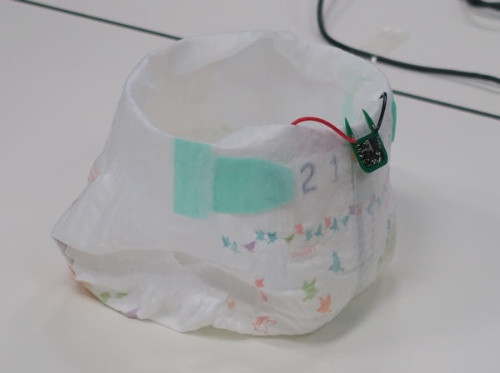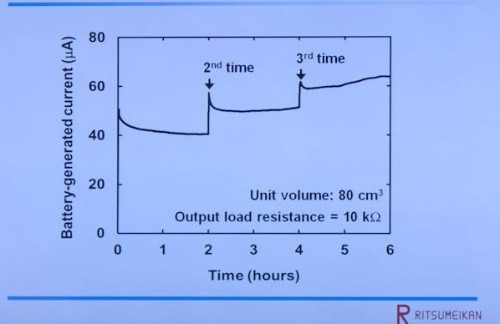One of the downside with current smart wearables is that most need to be recharged quite often, every day, week or month, and we’re still a long way of 10 year battery life offered by typical watches. I’m hopefully that eventually many devices won’t need to be recharged at all as we’ll have made improvements both in terms of power efficiency and energy harvesting using solar, body heat, vibrations and other techniques.
 Takakuni Douseki, professor at the Department of Electronic and Computer Engineering of Ritsumeikan University, has been working on micro energy harvesting, and his latest “wireless involuntary urination sensor system” notifies the user when it’s time change the diapers without the need of any battery, instead using energy generated by urine and stored in a capacitor in order to transmit the data wirelessly.
Takakuni Douseki, professor at the Department of Electronic and Computer Engineering of Ritsumeikan University, has been working on micro energy harvesting, and his latest “wireless involuntary urination sensor system” notifies the user when it’s time change the diapers without the need of any battery, instead using energy generated by urine and stored in a capacitor in order to transmit the data wirelessly.
The prototype is using a modified baby diaper with a 320x5mm activated carbon piece, and a 1.8mm aluminum electrode placed between the absorbent and a waterproof sheet. The amount of electricity generated increases with the amount of urine, with the current peaking at the time of “release” as shown in the chart below.
All that electricity is stored in a capacitor, and when the amount of urine reaches a threshold level (80 cm3), the system transmits an ID signal over a wireless connection up to 5 meters. The system may be commercialized later for example to care of patients suffering from incontinence. The research paper about urine energy harvesting and self-powered diaper can be found on IEEE website.

Jean-Luc started CNX Software in 2010 as a part-time endeavor, before quitting his job as a software engineering manager, and starting to write daily news, and reviews full time later in 2011.
Support CNX Software! Donate via cryptocurrencies, become a Patron on Patreon, or purchase goods on Amazon or Aliexpress. We also use affiliate links in articles to earn commissions if you make a purchase after clicking on those links.






Considering that babies have been crying when wet since forver, and are not much good at anything else except that (oh, crying when hungry too), I’m not sure an alarm for when wet is *that* useful, it’s already there ;-p
@obarthelemy
Good point. Maybe that’s why they plan to use it for the elderly instead.
I’d love to see an article on the state of human powered 5V/2A solutions.
The expression “motion pictures” on a TV box/SBC would gain a whole new level of meaning, imagine the fun and exercise! 🙂
@Shimon
Maybe a treadmill or bicycle used to generate energy stored in a battery connected to a TV box. Then no more couch potatoes!